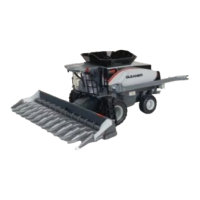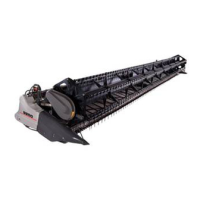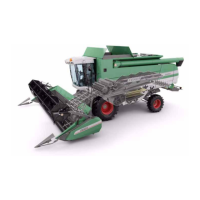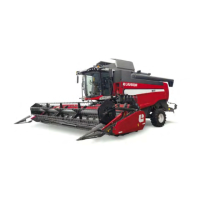“Advanced” grain loss calculation procedure
For the most accurate determination of grain lost through the combine
harvester, grain must be “caught” directly from the rotor discharge separately
from grain “caught” from the shoe discharge, and weighed.
TABLE 3 - CALCULATED LOSS IN TOTAL WEIGHT OF GRAIN PER
SWATH
15 ft. 20 ft. 25 ft. 30ft. 35ft. 40 ft.
Wheat (g)
9.3 12.4 15.5 18.6 21.7 24.8
Corn (g)
8.4 11.2 14.0 16.8 19.6 22.4
Soybeans (g)
9.3 12.4 15.5 18.6 21.7 24.8
Canola (g)
7.8 10.4 13.0 15.6 18.2 20.8
Canola
by
Volume
(mL)
18 24 30 36 42 48
Advanced rotor loss
1. Remove the straw spreader, the chaff spreader and raise the shoe
tailboard so that shoe and rotor discharge remain separate.
2. Use a pan, m
easuring one foot long and six feet wide to “drop” directly
in front of the rotor discharge
• Make sure that the pan dropped does not include any grain lost
from the shoe discharge
3. Sort out the grain from the rest of the material, and weigh the grain.
• Remember to subtract any pre-harvest loss, grain loss caused by
the header, or loss due to combine leaks in the field!
• Use TABLE 3 above to determine total grain loss from the rotor.
ADVANCED ROTOR LOSS EXAMPLE: a canola farmer has a 30-foot wide
header. He removes the straw spreader, the chaff spreader, and raises the shoe
tailboard. He measures a total of 6 grams in the rotor discharge path (from the
“drop” pan). With a 30-foot header, it takes 15.6 grams weighed to equal one
bushel loss, so 6 ÷ 15.6 = 0.38 bushels lost per acre from the rotor.
Advanced shoe loss
1. Remove the straw spreader, the chaff spreader, and raise the shoe
tailboard so that shoe and rotor discharge remain separate.
2. Use a pan, m
easuring one foot long and six feet wide to “drop” directly
in front of the shoe discharge.
• Make sure that the pan dropped does not include any grain lost
from the rotor discharge.
• Sort out the grain from the rest of the material, and weigh the grain.
3. Remember to subtract any pre-harvest loss, grain loss caused by the
header, or loss due to combine leaks in the field!
• Use TABLE 3 above to determine total grain loss from the rotor.
ADVANCED SHOE LOSS EXAMPLE: a soybean farmer has a 35-foot header.
He removes the straw spreader, the chaff spreader, and raises the shoe
tailboard. He measures a total of 10 grams in the path behind the shoe (from
the “drop” pan). With a 35-foot header, it takes 21.7 grams to equal one bushel
loss, so 10 ÷ 21.7 = 0.46 bushels lost per acre from the shoe.
28

